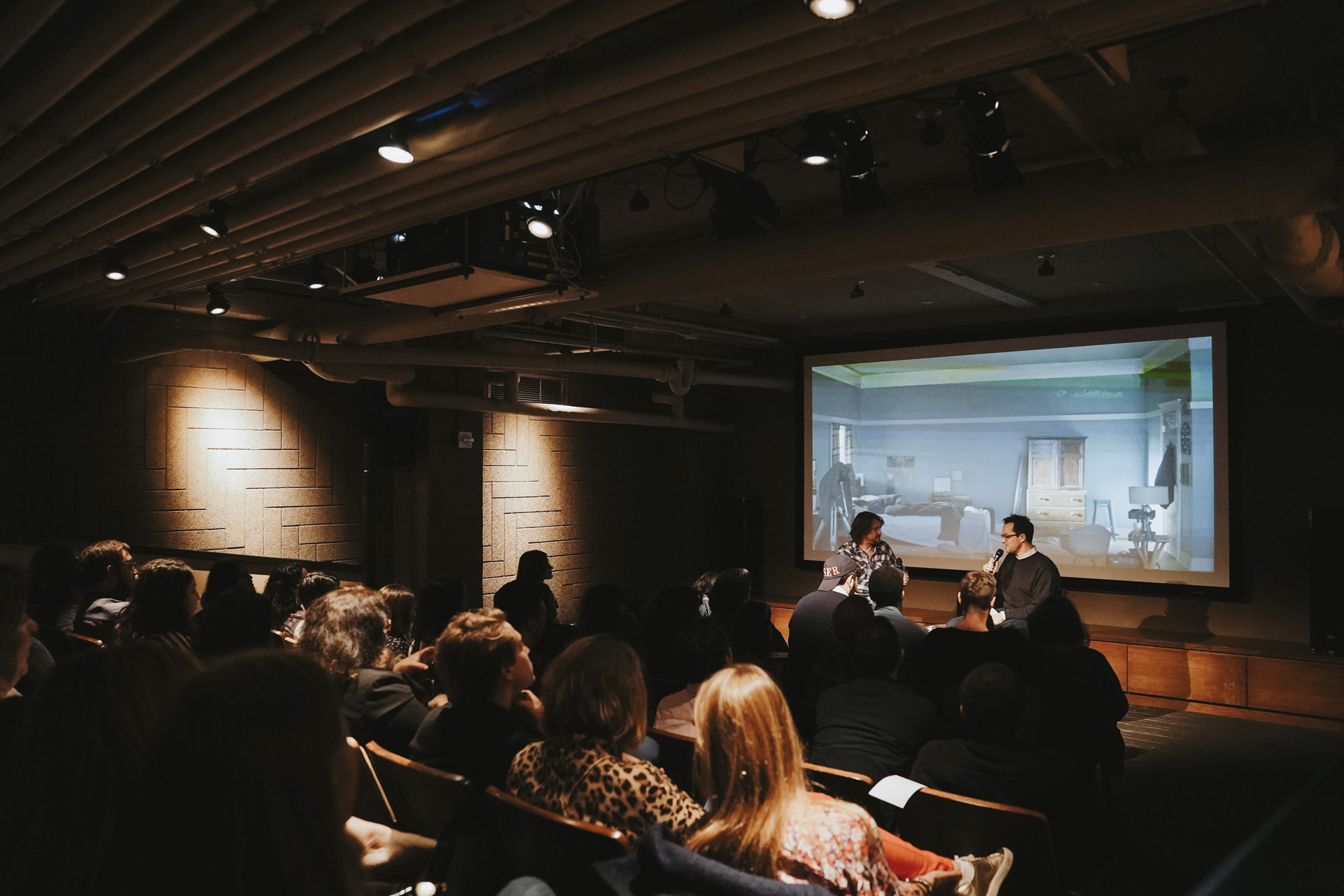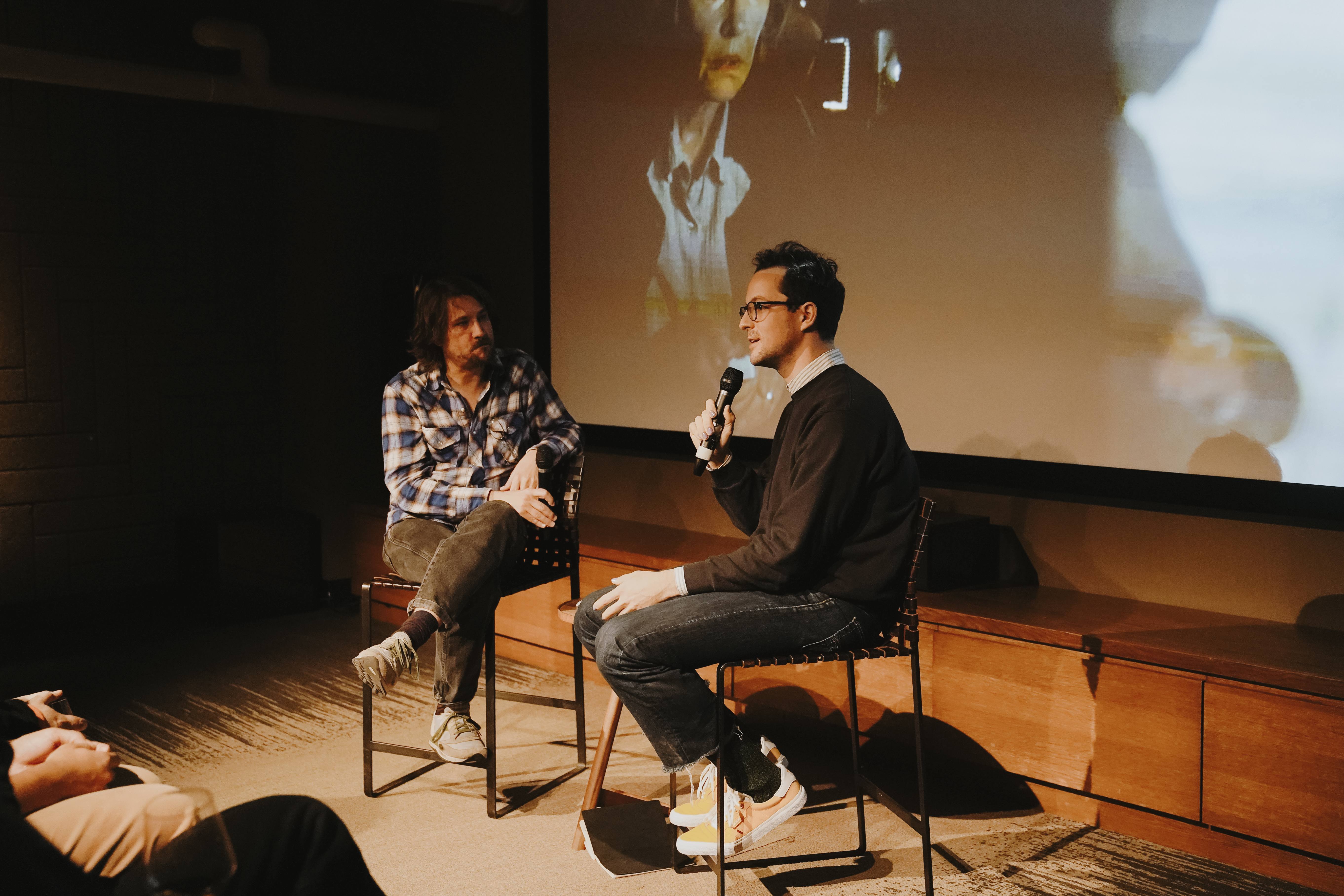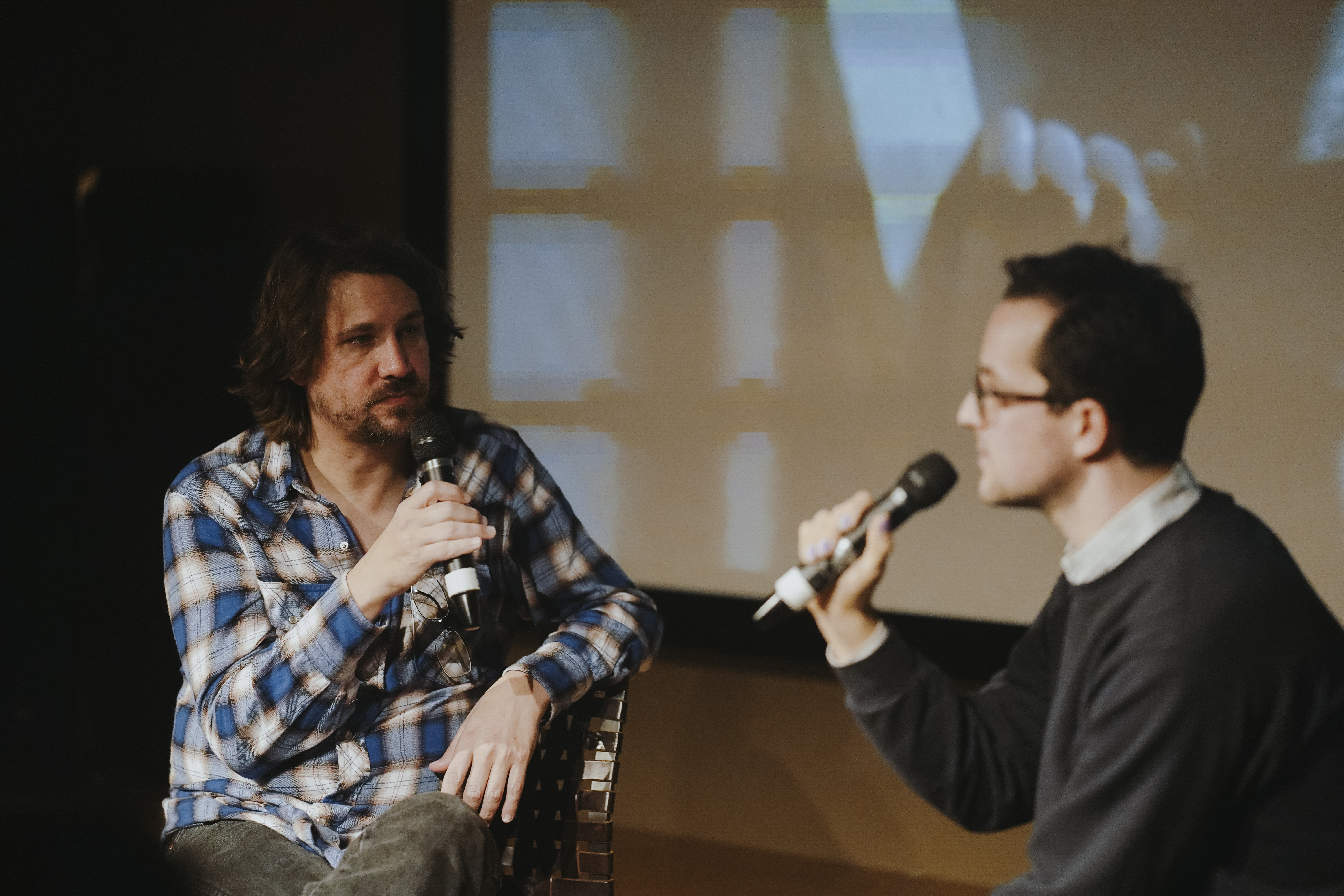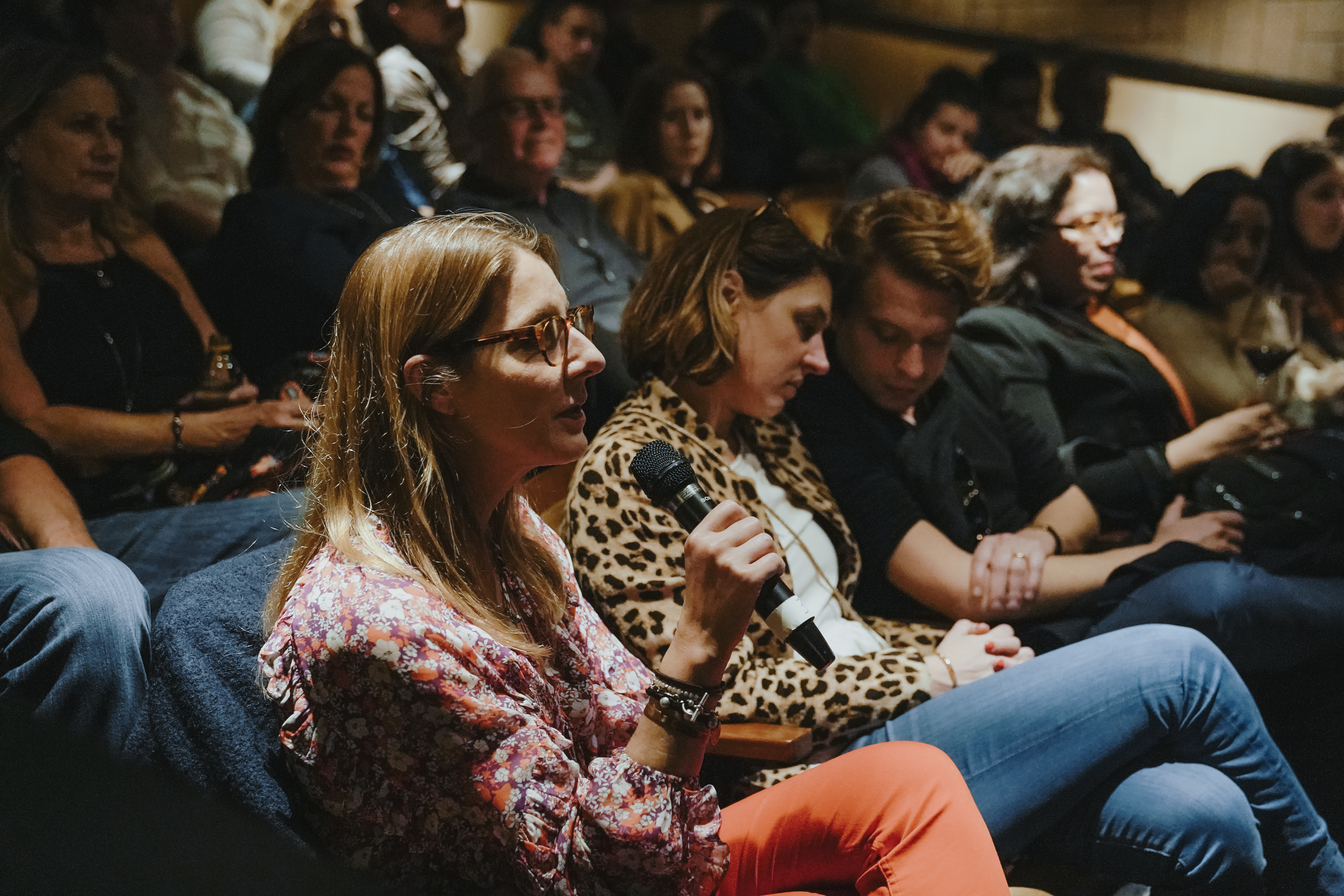Deep Focus
Horror, Contemporary Art, and Film: In Conversation with Dan Herschlein and Chad Laird

Dan Herschlein [left] and Chad Laird [right], “Horror, Contemporary Art, and Film, with Art21,” artist talk at NeueHouse, New York City, 2019. Photo: Jessica Foley.
This conversation was recorded at NeueHouse, in New York City, on October 28, 2019, during an event organized by Art21.

Dan Herschlein and Chad Laird, “Horror, Contemporary Art, and Film, with Art21,” artist talk at NeueHouse, New York City, 2019. Photo: Jessica Foley.
DAN HERSCHLEIN: Something that’s really important about horror movies is that they’re sort of like folk tales or fairy tales that get told and retold and recast and reframed. But they’re not that different [from each other]; they’re different peoples’ takes on similar kinds of stories and themes. So, you can take whatever you want from any one of them.
CHAD LAIRD: Why do you think you’re drawn to moments of suspension, which seem to always revolve around scanning a room or looking at a door or a slat or a window? What is it about that kind of narrative stop that attracts you?
“People take horror movies to be an almost conservative art form, but I think that they’re mirroring a real, normal, everyday structure.”
—Dan Herschlein
HERSCHLEIN: I think they are most related to when a person actually has to sit with a feeling, whether it’s sadness or anger or fear or grief of some kind. The thing that becomes hyper-present is just the room that you’re in, and it’s extremely mundane, but it’s also the worst thing ever. How do you show that? You show that in a film by emphasizing the weird lighting, the angle of the perspective of the room, or a specific object. I think this use value of objects is really interesting. What is the prescribed usefulness of an object? Like [in reference to Rope (1948) by Alfred Hitchcock], in a normal social situation, this rope does belong in that drawer.
LAIRD: Even the door in that scene is not really doing what it’s supposed to be doing. It’s hiding him but also showing him to us. It’s violating its normal function, which is what a lot of these doors are doing in these clips: they are thresholds that get us to think about boundaries being crossed, even [in reference to Pet Sematary (1989)] what’s under the sheet here.

Dan Herschlein and Chad Laird, “Horror, Contemporary Art, and Film, with Art21,” artist talk at NeueHouse, New York City, 2019. Photo: Jessica Foley.
LAIRD: One thing that’s interesting about these clips, in relation to your work, is that this is the scariest site that I think a lot of us ever have to deal with: being at home and in our rooms, mainly when we’re young, and thinking about what’s under the bed or what’s outside.
HERSCHLEIN: Right, and besides when we’re young or alone, it’s dealing with our expected behavior versus how we feel we need to behave or the way we do behave and don’t understand why. I think that the home is a space that emphasizes the rules and the narrative quality of those rules and how those define who we are and what we’re supposed to be. I think that people take horror movies to be an almost conservative art form, but I think that they’re mirroring a real, normal, everyday structure: you’re punished for questioning or examining.
LAIRD: That’s what’s interesting about the first clip, Hereditary (2018), with this woman who’s dealing with her grief by miniaturizing it; she’s constructing it. A lot of people think of horror as a mirror, which is really simple and just reflects spheres [of experience], and that’s all it does. But I like the way that the clips are set in motion by someone [in Hereditary] who is actively constructing a version of what they feel and fear at home, and I think that’s how these [films] relate to your work. It’s not a literal one-to-one reflection but [rather] a construction and exploration. It’s much more complicated.
HERSCHLEIN: That’s a perfect way to put it. Even your reflection is going to be impacted by what you think your reflection is supposed to be. A great example of that is when she’s like, “This is what my life is supposed to look like, so I’m going to rebuild it,” and then the story unfolds within what she’s built and really isn’t what she thought.

Dan Herschlein and Chad Laird, “Horror, Contemporary Art, and Film, with Art21,” artist talk at NeueHouse, New York City, 2019. Photo: Jessica Foley.
HERSCHLEIN: The weirdest part [in the clip from The Fly (1986)] is the reaction. Those are the moments of realism, I think, that get really freaky and under your skin. What would you do if your finger exploded on the mirror?
LAIRD: There are a lot of things [the character] could do, and he just sits down, which I think is interesting.
HERSCHLEIN: Right, it’s a moment of sitting down and trying to process [the event] in private, with a closed door, and trying to hide and wipe it away. Like, if you had this sort of medical emergency, you would want to tell somebody—but I love that he doesn’t.
LAIRD: Or, if someone was trying to invade your home, you might do more than close the curtain.
HERSCHLEIN: Right. That movie [Tormented (2014)] is terrible, but that scene is so good. It’s a perfect moment of existential theater, where she has to run around and close the sheer curtains to protect her from the pig invaders. That’s so utterly ridiculous. But it’s another example of [the idea that] your home is supposed to be this fortified space: this is where you are safe, this is where you belong, this is what you’re supposed to be doing. Nobody’s supposed to be coming in from outside. So, your panicked reaction would be to close the sheer curtains as fast as you can—that must work!

Dan Herschlein and Chad Laird, “Horror, Contemporary Art, and Film, with Art21,” artist talk at NeueHouse, New York City, 2019. Photo: Jessica Foley.
LAIRD: A lot of these [clips] link to the way that you address voyeurism, in that everyone is looking out. None of the voyeurs are outside looking in, except in Caché (2005). But in all these other clips, it’s a mode of being a voyeur where you’re looking out and not receiving the kind of meaning or satisfaction that we usually associate with voyeurism.
HERSCHLEIN: I hadn’t even thought of that. Caché is interesting to me in the sense that just the act of showing the characters what their day looks like in their house is enough to unhinge them. You walking into your house is enough to unravel everything.
“Horror genre, in film especially, has to do with violating boundaries that we accept as normal.”
—Chad Laird
LAIRD: Seeing what one’s normal day is like, in Caché, is about how that relates to all of the past stuff that they’ve done, where they’re trying to repress or forget at the same time. It makes me think of why that 45 Years (2015) clip is so central to the way that you put this together, in relation to the night. It’s this transgression of what we’re supposed to remember, what we’re supposed to know, and how we’re supposed to think—and how we relate to the people who are close to us, who might be very disturbingly strange to us at the same time, which is really horrifying.
HERSCHLEIN: Right. It creates this mood that these people are living in—that I think a lot of people live in every day, without the actual horror elements of it—where things don’t seem to add up. They don’t seem like the way they imagined themselves when they were younger: what you thought you’re supposed to look like, what you thought you’re supposed to do for a job. You realize that the meaning behind all those things is significantly more complicated.
LAIRD: Do you think all of the different kinds of negativity of this genre, where you look back on these ways that we end up, feeling sort of alienated and alone—that kernels of comfort come out of it? Where these bankrupt stupid promises that we’re given, and we come out of it feeling this way, so to look back on it through the genre of horror might be a way we can feel relieved or comforted?
HERSCHLEIN: Right, because it’s a sort of validation. You were talking about childhood fears or traumas: in a horror film, you get to reenact or relive these things, at a safe distance. You get to go through them and intellectualize them while at the same time your body still has this visceral response to it, but it’s safe, and you can extrapolate from that. You can start to make new guidelines for your life. You just have a new lens for examining.

“Horror, Contemporary Art, and Film, with Art21,” artist talk with Dan Herschlein and Chad Laird at NeueHouse, New York City, 2019. Photo: Jessica Foley.
Q&A
SPEAKER 1: I’ve never heard anybody compare horror movies to fairy tales. We grew up with the Grimms’ fairy tales, and I thought they were the most fun of all the [children’s] stories; obviously, if somebody put them in pictures, yikes, I mean it would be kind of a grim thing. Were you always aware of this connection to fairy tales, and do particular fairy tales from your childhood keep coming back to you?
“Fairy tales tend to treat the normal world as bad.”
—Chad Laird
HERSCHLEIN: The way I relate [horror movies] to fairy tales is more of my adult self looking at them, but when I was a kid, I was really interested in horror movies and science-fiction movies. I really loved Alien (1979) and Predator (1987). I don’t think that Alien vs. Predator (2004) had come out yet, but I made my dad tell me “Alien versus Predator” bedtime stories, and he would just have to make them up as he went along. There’s a fan-fiction quality to horror and science fiction that I think is directly related to fairy tales, in that they’re the stories that you tell people to pass the time, that express things somewhat unconsciously through the storytelling.
LAIRD: There are two interesting connections between horror and fairy tales that I’m interested in. One is that so much of the horror genre, in film especially, has to do with violating boundaries that we accept as normal. Fairy tales have traditionally been about navigating the boundary between childhood and adulthood and how horrifying the transition out of childhood and into adulthood is—usually told from the tale of a girl entering womanhood. The second thing I find interesting, is that fairy tales tend to treat the normal world as bad, which is something horror movies also do. The world of childhood is safe and secure, and then, when you go out and deliver the food to grandma, it’s that normal world that’s really bad and horrifying. Some of the more interesting examples of the horror genre follow that kind of structure, where the normal is the bad and navigating your way through that horrible, normal world is the driving element of the horror.
HERSCHLEIN: Also, fairy tales are usually told from the perspective of a child. While horror films are not, the camera angles look like they could be, because a lot of the camera angles are from a hiding adult, which is low down, and there’s lots of floor to mid-wall angles in horror films. These set up a perspective that is inherently childlike, but the only way you can access that again as an adult is through utter terror.
